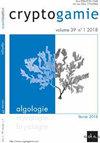Intraindividual variation in nuclear DNA content in Durvillaea antarctica (Chamisso) Hariot, Macrocystis pyrifera (Linnaeus) C. Agardh and Lessonia spicata (Suhr) Santelices (Phaeophyceae)
IF 1.5
4区 生物学
Q3 MARINE & FRESHWATER BIOLOGY
引用次数: 2
Abstract
ABSTRACT Macrocystis C. Agardh, Durvillaea Bory and Lessonia Bory are three brown seaweeds genera of commercial importance for Chilean fishermen. Macrocystis pyrifera (Linnaeus) C. Agardh (Laminariales, Laminariaceae) is one of the world's most ecologically and economically important seaweed collected in Chile for alginate extraction; and as food for abalone aquaculture, Lessonia spicata (Suhr) Santelices (Laminariales, Lessoniaceae) represents more than 70% of the total brown seaweeds annual landing in Chile; and Durvillaea antarctica (Chamisso) Hariot (Fucales, Durvillaeaceae) is consumed as food, being considered very healthy because of its iodine content. Despite the economic importance of these species their nuclear DNA content is unknown until this moment. The present research was initiated to determine the nuclear DNA content and the intraindividual ploidy level variation in these seaweeds. The DNA-localizing fluorochrome DAPI (4′,6-diamidino-2-phenylindole) and red blood cell (chicken erythrocyte) standard were used to estimate the nuclear DNA contents by image analysis. Durvillaea antarctica presented lower 2C DNA (1.2 pg) content and narrower range of DNA contents (1C-2C) than the Laminariales, which showed higher 2C DNA contents (1.4 -1.5 pg) and a wider range of ploidy level, achieving up to 4C in L. spicata and up to 8C in M. pyrifera. This higher ploidy levels observed would be related with the more complex cortical organization in the Laminariales than D. antarctica. 1C nuclei were only found in mature antheridia (D. antarctica) and sporangia (M. pyrifera and L. spicata). The 2C values observed for the taxa assessed were in the range of other previously published Fucales and Laminariales.Durvillaea antarctica (Chamisso) Hariot、Macrocystis pyrifera (Linnaeus) C. Agardh和Lessonia spicata (Suhr) Santelices (Phaeophyceae)核DNA含量的个体内变异
Macrocystis C. Agardh、Durvillaea Bory和Lessonia Bory是智利渔民具有重要商业价值的三个褐藻属。Macrocystis pyrifera (Linnaeus) C. Agardh (Laminariales, Laminariaceae)是世界上最重要的生态和经济海藻之一,采自智利用于提取海藻酸盐;作为鲍鱼养殖的食物,Lessonia spicata (Suhr) Santelices (Laminariales, Lessoniaceae)占智利每年登陆褐海藻总数的70%以上;和Durvillaea antarctica (Chamisso) Hariot (Fucales, durvillae科)被认为是非常健康的食物,因为它的碘含量很高。尽管这些物种具有重要的经济意义,但它们的核DNA含量直到现在才为人所知。本研究旨在确定这些海藻的核DNA含量和个体内倍性水平的变异。采用DNA定位荧光染料DAPI(4′,6-二氨基-2-苯基吲哚)和红细胞(鸡红细胞)标准品,通过图像分析估计细胞核DNA含量。与叠层藻相比,南极杜氏菌2C DNA含量(1.2 pg)较低,2C DNA含量范围(1C-2C)较窄,而叠层藻2C DNA含量(1.4 ~ 1.5 pg)较高,倍性水平范围较宽,spicata达4C, pyrifera达8C。所观察到的高倍性水平可能与叠层虫比南极陆龟具有更复杂的皮层组织有关。1C核只存在于成熟的孢子囊(D. antarctica)和孢子囊(M. pyrifera和L. spicata)中。该分类群的2C值在其他已发表的岩藻目和层藻目的范围内。
本文章由计算机程序翻译,如有差异,请以英文原文为准。
求助全文
约1分钟内获得全文
求助全文
来源期刊

Cryptogamie Algologie
生物-海洋与淡水生物学
CiteScore
2.60
自引率
7.70%
发文量
11
审稿时长
>12 weeks
期刊介绍:
Cryptogamie is a fast-track and peer-reviewed journal of international scope publishing in English only. It accepts original papers and review articles on the taxonomy, biology and ecology of all cryptogams. An issue of Cryptogamie may be devoted to a single topic, under the responsibility of guest editor(s). All articles published in Cryptogamie are compliant with the different nomenclatural codes. A copyright assignment will be signed by the authors before publication.
Cryptogamie, Algologie accepts articles on systematics as well as ecology and evolution of any kind of algae (including Cyanobacteria).
 求助内容:
求助内容: 应助结果提醒方式:
应助结果提醒方式:


